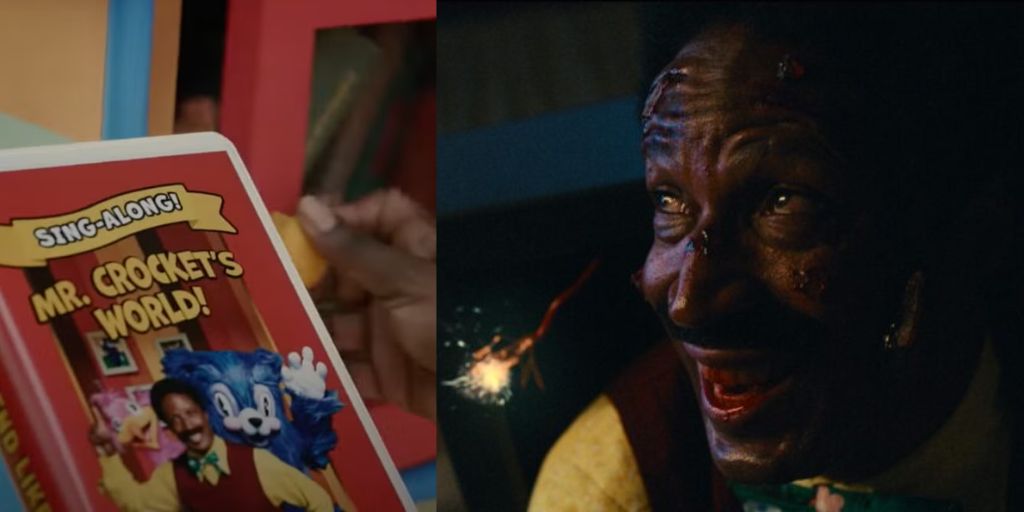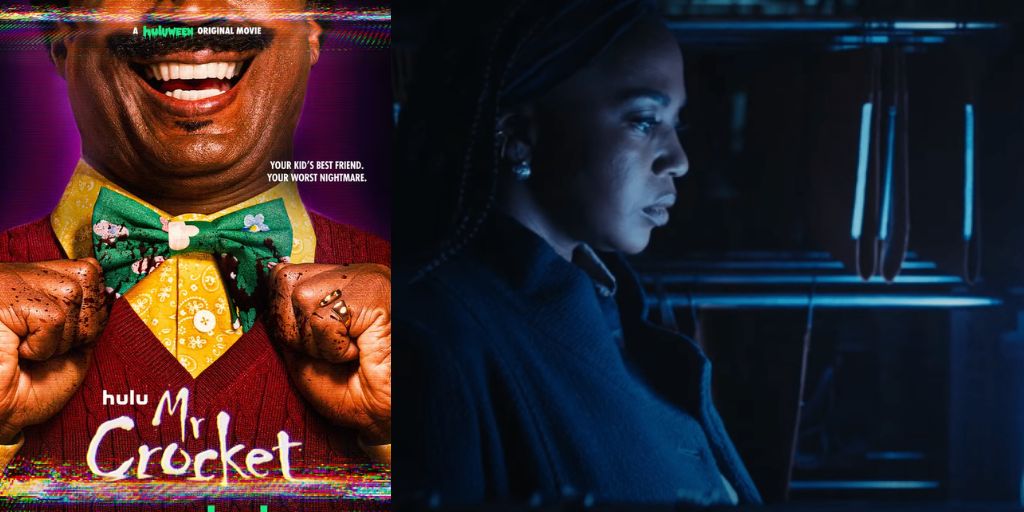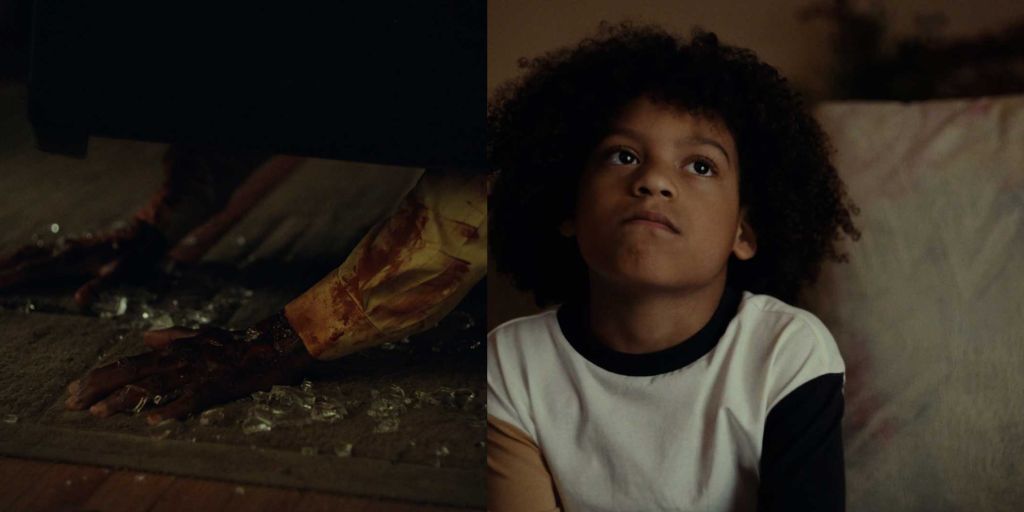Brandon Espy’s Mr. Crocket began as a six-minute horror short for Hulu’s Bite Size Halloween collection in 2021. Two years later, it expanded into a full feature that is now part of Hulu’s 2024 Huluween lineup. The movie takes a dark twist on beloved children’s shows, reminiscent of Pee-wee’s Playhouse and Mister Rogers’ Neighborhood, infused with the sharp wit of slasher film icon Freddy Krueger.
Espy’s examination of parenthood and children’s television has practical effects designed to frighten young viewers expecting innocent fun. However, like many adaptations from short films to feature-length productions, Mr. Crocket struggles to maintain a coherent story as it stretches to fill the time, yet it still provides a wickedly entertaining Halloween experience in a tight 90-minute format.
A Struggling Mother and Her Son
The film stars Jerrika Hinton as Summer, a single mother grappling with her son Major’s (played by Ayden Gavin) behavior following the tragic death of her husband. The story kicks off when a mysterious community book box falls from the sky outside Summer’s home. Inside, she finds a singalong video titled Mr. Crocket’s World.
Major quickly becomes obsessed with the video, glued to the screen whenever it plays. When Summer tries to intervene and limit his viewing, Major throws a tantrum and is sent to his room. This moment escalates when Summer hears a familiar voice coming from behind a locked door.
To her horror, Mr. Crocket (portrayed by Elvis Nolasco) manifests in real life, using his “magic marker” to kidnap Major—leaving Summer desperate to figure out where they have gone.

The Creative Vision Behind Mr. Crocket
Espy’s creativity shines throughout Mr. Crocket. The film features clear references to childhood staples, like Pee-wee’s special friends. However, Espy puts a sinister twist on these characters, placing Mr. Crocket’s hideout in Hell. What initially appears to be a wholesome public access set is a deceptive facade. Mr. Crocket’s companions transform into nightmarish versions of animated furniture and characters.
One standout is Blue, a monstrous teddy bear with exposed brains and razor-sharp claws. Espy cleverly incorporates design elements reminiscent of other children’s shows, such as Barney & Friends and Teletubbies, creating a disturbing vision of a child’s play area twisted into a nightmarish environment.
Espy excels at transforming beloved childhood characters into horrifying figures, which creates a strong visual impact. Nolasco’s portrayal of Mr. Crocket embodies the archetypal children’s host but with a malevolent twist. His character uses education to teach “naughty” parents a lesson, resulting in gruesome deaths.
Nolasco perfectly embodies the duality of his role, expertly balancing the cheerful demeanor of a children’s entertainer with the sinister undertones of a predator. His character retains a wide smile while leading children into horrifying situations, reminding viewers of how dangerous charm can be in the wrong hands.
Investigating Mr. Crocket’s Urban Legend
As Summer investigates the legend of Mr. Crocket, the plot becomes less compelling. Espy and co-writer Carl Reid use cryptic tropes, leaving much of the backstory underexplained. Summer’s search for answers is aided by a homeless mother, Rhonda (Kristolyn Lloyd), who has also encountered Mr. Crocket.
Rhonda embodies the archetypal “crazy lady,” adding a layer of absurdity to the story. Additionally, a father named Eddie (Alex Akpobome) becomes an overly interested character, whose eagerness hints at predictable plot developments.
Rhonda, in particular, provides insight into Mr. Crocket’s powers. Her scenes highlight a contrast between sanity and insanity, raising questions about the reliability of characters in the story. She taps into Mr. Crocket’s essence over a set of hardwired television sets in her makeshift workshop.
Meanwhile, Eddie’s overt enthusiasm creates tension as his character pushes the narrative toward expected reveals. Espy succeeds in justifying the film’s runtime, yet the attempt to expand upon the short’s premise raises questions about adapting such a brief idea into a feature film.
While the film depicts the ups and downs of parenthood with some honesty, the exploration of these themes feels underwhelming compared to the horror elements.
However, audiences watching Mr. Crocket primarily come for the gore, and Espy delivers on this front. The film showcases practical effects in creative ways, providing thrills and chills that are often missing from family-friendly entertainment.

A Showcase of Practical Effects
From the start, Mr. Crocket establishes a commitment to practical effects that heighten the horror experience. In one shocking scene, Rhonda’s husband falls victim to Mr. Crocket’s brutal form of discipline, resulting in graphic imagery as his torso is sliced open, spilling his intestines.
This early moment sets a grim tone for the rest of the film, preparing audiences for the violent spectacle to come. The creativity in the effects design is impressive, blending macabre humor with startling visuals.
The scenes featuring Blue, the psychotic bird puppet, and other anthropomorphic figures serve as reminders that childhood innocence can easily be corrupted. Espy incorporates these characters into violent sequences, showcasing the disintegration of safety that children often associate with their favorite shows. Each gruesome death scene reinforces the film’s premise that the familiar can become horrific, inviting viewers to reconsider their own childhood experiences with television.
Themes of Parenthood and Media Influence
Amid the gore, Mr. Crocket invites viewers to reflect on broader themes of parenting and the media’s influence on children. Summer’s fight to save her son from Mr. Crocket represents a parent’s ultimate fear: losing control over their child. The film critiques the media that often overwhelm children with content, posing the question of whether parents can truly protect their children from the dark influences that lurk in entertainment.
The obsession Major develops with Mr. Crocket mirrors the concerns many parents face today regarding their children’s screen time. The film does not shy away from portraying the psychological impacts of children’s programming, highlighting how easily a child’s innocence can be shattered by dark themes presented in seemingly harmless shows.
The Climax and Resolution
As the plot progresses, the tension continues to rise, leading to an intense climax where Summer confronts Mr. Crocket. This showdown is not just about physical survival; it also represents a deeper emotional struggle.
Summer must confront her own fears and insecurities as a parent, fighting not only for Major’s safety but also to reclaim her role as a protective mother. The emotional stakes make this climax all the more compelling, engaging viewers who may have similar fears of losing their loved ones.
The final confrontation sees Summer battling against Mr. Crocket in a series of visually striking sequences that blend horror with a touch of dark comedy. Espy manages to create a climactic battle that feels both satisfying and chaotic, echoing the unpredictability of parenthood itself.
Despite the film’s dark themes, it concludes with an open-ended resolution that leaves viewers pondering the consequences of Mr. Crocket’s influence. While Summer may have saved her son, the scars left behind by their experiences remain. This conclusion invites discussions about the nature of evil and the complexities of raising children in a media-driven world.

Final Thoughts on Mr. Crocket
Mr. Crocket presents a fresh take on horror that encourages audiences to rethink their perceptions of children’s media. While it may not redefine the horror genre, it offers a compelling narrative that fuses themes of nostalgia, parental anxiety, and the darker undercurrents of childhood entertainment. Espy’s ability to blend horror with poignant commentary on parenting showcases his potential as a filmmaker.
The film stands out in a crowd of horror films, offering a unique perspective that resonates with both children and adults. Espy creates an atmosphere that is both entertaining and thought-provoking, making Mr. Crocket a worthwhile addition to any Halloween viewing list.
Mr. Crocket stands out as a daring and innovative horror film that challenges traditional views of children’s entertainment. By taking familiar elements from beloved children’s programs and twisting them into dark, disturbing narratives, the film invites viewers to reconsider the influence of media on young minds.
Espy expertly crafts a chilling atmosphere that balances horror with thought-provoking commentary on parenthood and the struggles that come with raising children in an increasingly complex world.
The character of Mr. Crocket embodies the potential dangers hidden beneath the surface of seemingly innocent programming, serving as a reminder that not everything meant for children is devoid of dark themes.
As Summer fears and ultimately confronts Mr. Crocket, the film goes into deeper emotional territories, exploring the anxiety parents face when trying to protect their children from external threats. This connection resonates with audiences, highlighting the importance of vigilance in a world where media plays a significant role in shaping children’s perceptions and behaviors.
Moreover, the film’s use of practical effects and creative storytelling amplifies its effectiveness, providing memorable visuals that stick with viewers long after the credits roll. While Mr. Crocket may not fit the mold of a traditional family film, it serves as a powerful reminder of the necessity for parents to engage with their children’s media choices and the potential ramifications of unchecked consumption.
Espy’s film, with its mix of horror and commentary, leaves an indelible mark on the genre, encouraging both parents and children to reflect on the darker implications of entertainment. As it challenges the boundaries of horror and nostalgia, Mr. Crocket firmly establishes itself as a notable entry in contemporary horror cinema.





